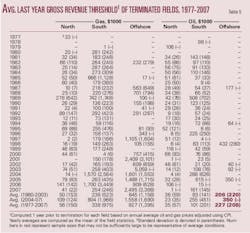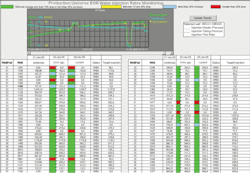Bruce S. Hart
New Mexico Bureau of Mines and Mineral Resources
Socorro
Increased optimism in the Permian Basin is helping to stimulate interest in the Leonardian (Permian) Bone Spring formation of the Delaware basin. Relatively little has been published on this unit since the late 1980s. As such, a shift in emphasis on drilling targets that has taken place has gone largely undocumented.
Whereas carbonate and clastic slope deposits have traditionally been considered as the principal exploration targets, in recent years clastic units of the basinal areas of the Bone Spring have been responsible for the best producing fields. These basinal deposits should now be considered the most prospective exploration targets in the formation.
This article presents an analysis of historical production data for the Bone Spring formation that was prepared for presentation to the Roswell Geological Society in January 1997 and the West Texas Geological Society in June 1997. It represents the initial findings of a multicomponent study of the Bone Spring that is being undertaken at the New Mexico Bureau of Mines.
Data presented herein were derived from scout tickets, production data, and logs archived at the Petroleum Resource Center (New Mexico Bureau of Mines), from field summaries in Roswell Geological Society publications, and from other sources cited in the bibliography. A summary of the geology of existing Bone Spring fields will be presented elsewhere (Hart, in prep.).
Stratigraphy
Stratigraphic complexities play an important role in the development of Bone Spring fields.
The entire formation averages approximately 3,500 ft thick, but it can be subdivided into carbonate and clastic ("sand") members that were deposited in a slope and basin setting. Relative sea level changes are thought to have caused reciprocal sedimentation, with carbonates deposited during transgression and highstand, while clastics were deposited during lowstand. Production is from both carbonate and clastic units, and multiple pay horizons are present within the Bone Spring at many locations.
Syndepositional relief in the Delaware basin played a major role in determining depositional styles. Landward, the Bone Spring is transitional into shelfal deposits of the Abo and Yeso formations (Fig. 1). Slope margin carbonate detritus was transported downslope by density currents and other types of mass wasting (i.e., slumps) to become intercalated with undisturbed slope carbonate muds during highstands and transgressive intervals. Porosity in the carbonates is generally secondary.
The siliciclastic members, deposited during lowstands, tend to pinch out onto the slope. Both density currents and settling from aeolian transport have been suggested for parts of the "sands" which away from the shelf are usually comprised of very fine sand to silt. In several respects (e.g., log analysis) these relatively fine-grained siliciclastic units are similar to basinal deposits of the overlying (Guadalupian) Delaware Mountain Group.
Production trends
By the end of 1995, 113 Bone Spring fields had been created (Fig. 2), with most established since the late 1970s. Just over 50% of the Bone Spring fields had nominal depths between 8,000-10,000 ft, with some more than 10,000 ft.
Interest in the Bone Spring waned somewhat as oil prices dropped, and most exploration was directed toward the sands of the overlying Delaware Mountain Group. Workovers of wells drilled for deeper objectives were responsible for the establishment of many new fields. The cost of drilling wells this deep, when compared to drilling shallower targets, and depressed oil prices led many operators to view the formation as a secondary target.
The establishment of new production in the Bone Spring in recent years has helped to stimulate exploration. Although workovers of existing wells continue to make a significant contribution, approximately 70 and 80 wells were drilled for oil in the Bone Spring in 1994 and 1995, respectively, and this interest appears to have continued on into 1996 and 1997. Nearly all the activity has been in Lea and Eddy counties, N.M., although Bone Spring production has been established in the War-Wink area of West Texas.
Historically, large fields have produced most of the Bone Spring oil. By the end of 1995, the last year for which production data are available at this writing, the formation had produced nearly 54 million bbl of oil from 113 fields. Twelve fields had produced over 1 million bbl each, and these accounted for 85% of the total production. Over two thirds of the fields had produced less than 100,000 bbl. Eighty percent of the fields consisted of five or fewer wells (Fig. 3).
A plot of 1995 production versus cumulative production (Fig. 4) shows three main groupings. First, there were many low production (e.g., one well) fields. Second, the six fields that had the greatest cumulative production all had less than 1,000 bbl/well/month production in 1995. All of these fields, slope plays, were over 10 years old in that year. Third, all but one of the six best producing fields ( 1,000 bbl/ well/month) were less than 5 years old. As described below, the exception, Sand Dunes South, was a relatively poor producer from 1984 to mid-1994, when the true potential of the field was realized. Furthermore, of these six "hot producers," all but one (Mid Vacuum) were from the basinal part of the formation.
Traditional slope plays
Ten years ago, the primary interest was focused on a diagenetic fairway that extends approximately 12 miles from the shelf margin. Porous dolomitized debris mounds were the predominant drilling targets here, although upslope pinchouts of sands have also been established as being productive in these areas. Most of these fields have multiple pay horizons in the formation.
Fields such as Scharb (18s-35e), Airstrip (18s-34e), and North Shugart (18s-31e) are predominantly slope carbonate plays.
Like the other large slope carbonate fields, Scharb field appears to be in the final stages of decline (Fig. 5). Established in 1962 when the Marathon 1 State "NPA" flowed 114 b/d of oil from the Bone Spring, this became the first large field in the Bone Spring formation. Fourteen wells had produced over 1.3 million bbl of oil by the end of 1965. Production data show two periods of peak production, the first in the 1960s, the biggest in the mid-1980s. These two peaks correspond to the development of two separate pay zones:
a. the "Scharb pay," a dolostone unit within the Second Sand that was discovered and developed in the 1960s, and
b. the "Elkan pay," another dolostone at the top of the Second Carbonate that was discovered and developed during the 1980s. Although annual production peaked at over 2 million bbl/year in the mid-1980s, it had dropped to only 66,000 bbl/year from 20 wells in 1995.
In addition to slope carbonates, some slope fields have produced from the upslope pinchout of porous units in the Bone Spring sand members. For example, Querecho Plains Upper Bone Spring field (18s-32e) produces from the First Sand and had cumulative production of over 1.8 million bbl by the end of 1995. Young North field (18s-32e) produces from the Second Sand, with 61 wells (56 pumping and five flowing, combined with four injection wells and 12 shut in) producing 462,000 bbl of oil in 1995.
Only one slope play, Mid Vacuum field (18s-35e), produced over 1,000 bbl/well/ month in 1995. Despite good initial flow rates, wells in this field were choked back in 1995 to control water production. The historical production data suggest that although some good plays may yet be discovered on the slope, the Bone Spring is most prospective in the basinal areas described next.
New basinal plays
Within the past several years, interest in and production from the basinal clastics of the formation have been increasing. In fact, most of the best producing fields are from clastics in the basinal part of the Bone Spring. Two fields, Sand Dunes South and Red Hills, illustrate the nature of these fields.
Sand Dunes South field (23s-32e) was established in 1984. Production, originally from the Third Bone Spring sand, had declined to approximately 700 bbl/month from two wells by early 1994 (Fig. 6). In August of that year, production was established at a higher stratigraphic level in the Bone Spring only a couple of miles to the south in Mesa Verde field (24s-32e). That production came from a unit informally termed the "Avalon Sand," near the top of the formation in the First Carbonate. The Mesa Verde production prompted a reevaluation of the Sand Dunes South area, and by November 1994 new wells were drilled and production had been established from the Avalon sand at that field. Monthly production from Sand Dunes South field jumped an order of magnitude to over 7,000 bbl/ month.
Red Hills field (23s-33e and 34e) was the most productive Bone Spring field in 1995. Established in 1993 when the 1 Hallwood "12" Federal tested 65 b/d of oil and 1 b/d of water from the Third Sand, 35 wells were producing 103,000 bbl/ month combined by the end of 1995 (Fig. 7). Of those, 33 wells were flowing as the sands are overpressured at the target depth (about 12,300 ft). As the only field producing more than 2,000 bbl/well/month in 1995 and the only "new" field to have produced more than 2 million bbl by the end of that year, Red Hills field should be regarded as the new "type" play for Bone Spring exploration. Other Bone Spring Third Sand production has been established elsewhere, most notably to the south in Texas at War-Wink field (Block 18, UL Survey, Ward County, Tex.).
Future challenges
Given the risks (e.g., a 12,500 ft dry hole targeting the Third Sand could cost in excess of $750,000, an economic impediment to some of the small producers active in the basin) but potential rewards of current exploration targets in the basin, explorationists need to develop and utilize risk reduction tools that will help identify structures and porosity in the sparsely drilled areas in the Delaware basin.
Although some still view the Bone Spring only as a secondary target, the production that has been established from Sand Hills South, Red Hills, Red Tank, and other basinal fields is alluring to many others.
Three dimensional seismic will be able to help define structures, but the ability of the technology to identify porous zones remains to be proven. There are some promising signs, however. When porosity is plotted against acoustic impedance (both properties derived from logs) from a number of fields, it can be seen that there is a significant difference in physical properties between porous (typically siliceous dolomites and dolomitic sandstones) and nonporous rocks (Fig. 8). Understanding how (or if) those differences manifest themselves in seismic data is the topic of a research program at the Bureau of Mines. Most promise would appear to be for the siliciclastic units that are currently the primary exploration targets in the basinal part of the formation.
Refining the stratigraphy of the Bone Spring is another need. The origin of units such as the Avalon sand or Third sand remains somewhat controversial within the industry. Depositional models need to be established to help high-grade exploration efforts for undiscovered pools. Additionally, the stratigraphic complexities of the slope areas should be reviewed using current carbonate sequence stratigraphic concepts to help evaluate their remaining potential. Three dimensional seismic data are currently being examined at the Bureau of Mines to this end.
Summary
Historical production data show that a change in emphasis has occurred for the Bone Spring formation. Although it is probable that some good production will still be discovered from the slope portions of the formation, the most significant undiscovered production is undoubtedly in the basinal areas. Unfortunately, there is very little published to guide exploration in those areas. New studies are needed to help to fill that gap in our knowledge.
Acknowledgments
I thank Ron Broadhead, Ralph Worthington, Mike Hayes, Bill Bradshaw, Tim Miller, Larry Brooks, and other members of the Roswell Geological Society for their insights. I am solely responsible for any errors or omissions. Three dimensional seismic data currently being studied at the Bureau of Mines were donated by Harvey E. Yates Co., in collaboration with Santa Fe Energy, and Marathon.
Bibliography
Bradshaw, W.A., Carbonate petrology and diagenesis of the Bone Spring formation dolostones, Scharb field, Lea County, N.M., unpublished master's thesis, West Texas State University, 1989, 135 p.
Broadhead, R.F., Oil and gas activities in New Mexico in 1994, New Mexico Geology, Vol. 17, 1995, pp. 54-59.
Broadhead, R.F., Oil and gas activities in New Mexico in 1995, New Mexico Geology, Vol. 18, 1996, pp. 97-103.
Gawloski, T.F., Nature, distribution, and petroleum potential of Bone Spring detrital sediments along the northwest shelf of the Delaware basin, in, Cromwell, D., and Mazzullo, L.J., (eds.), The Leonardian facies in W. Texas and S.E. New Mexico and Guidebook to the Glass Mountains, SEPM, Permian Basin Section Publication No. 87-27, 1987, pp. 85-105.
Hart, B.S., in prep., The stratigraphic context of Bone Spring production: problems and potential, West Texas Geological Society Bull.
Lorenz, J.C., and Brooks, L.L., Suspension- and current-deposit reservoirs in the Delaware basin: trends and cycles in siltstones of the Permian Bone Spring limestone, AAPG Bull., 1990, p. 708.
The Author
Bruce Hart has been a petroleum geologist with the New Mexico Bureau of Mines since 1995. He previously held positions with the Geological Survey of Canada and the Penn State Department of Geosciences. His main research interests lie in understanding how sedimentary strata are deposited and how seismic methods can be used to study those rocks. He has an Honors BA from McMaster University, an MSc from the Université du Québec à Rimouski, and a PhD from the University of Western Ontario. He maintains a website at http://www.nmt.edu/~hart
Copyright 1997 Oil & Gas Journal. All Rights Reserved.






